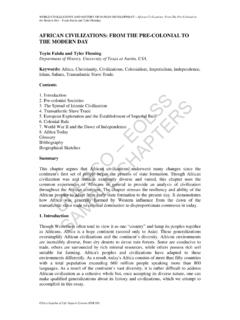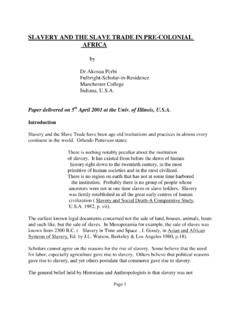Transcription of Environmental Impacts of Foreign Direct Investment in the ...
1 OECD GLOBAL FORUM ON INTERNATIONAL INVESTMENTC onference on Foreign Direct Investment and the EnvironmentLessons to be Learned from the Mining Sector7 - 8 February 2002 OECD Headquarters, 2 rue Andr Pascal, 75775 CEDEX 16, Paris, FranceEnvironmental Impacts of Foreign Direct Investment in the Mining SectorinSub-Saharan AfricaColin Noy BoocockJanuary 2002 CONTENTS1. 12. 13. FDI and its Environmental Impacts in the mining sector in selected Sub-Saharan South africa .. Zambia .. Mali .. Tanzania .. Kenya .. 204. Conclusions and .. 27 Appendix ITOCPAGEREFPAGEREFPAGEREFPAGEREFPAGEREFP AGEREFPAGEREFPAGEREFPAGEREFPAGEREFPAGERE FPAGEREFPAGEREFPAGEREFPAGEREFPAGEREFPAGE REFPAGEREFPAGEREF1 PAGE1. BackgroundForeign Direct Investment is important to the future of development of africa , as it is a means ofincreasing the capital available for Investment and the economic growth needed to reduce poverty andraise living standards in the continent. In addition, it can contribute to sustainable economicdevelopment, as it can result in the transfer of new technologies, skills and production methods,provide access to international markets, enhance efficiency of resource use, reduce waste andpollution, increase product diversity and generate employment (Loots, 1999; Ngowi, 2001;UNCTAD,1997).
2 However, in the absence of regulations governing natural resource extraction, or when they areweak or poorly enforced, increased openness to Foreign Investment can accelerate unsustainableresource use patterns. The ability of developing countries to attract FDI, maximise the associatedbenefits and minimise the risks depends on the effectiveness of their policy/institutional frameworksand institutions (Wilhelms, 1998; Pigato, 2001).The aim of this paper is to review and analyse both the positive and negative Environmental effects ofFDI in the mining industry in Sub-Saharan africa . The physical Environmental Impacts will be the mainconcern, but relevant social issues will be explored, where they have a significant bearing on thebalance of benefits/risks associated with FDI or where they are closely related to the analysis will lead to the formulation of policy recommendations for enhancing the Environmental (and where relevant social) performance of FDI in the mining sectors and maximise the benefits ofFDI.
3 This will include:1) measures which can be taken by host countries, notably to improve policy/institutional/regulatoryframework s both to attract FDI flows and to monitor compliance with applicable rules;2) measures which can be taken by Foreign investors to improve their performance;3) measures which OECD countries governments can take to support 1) and 2).The analysis will focus on West, East and Southern africa . Five countries, which have succeeded inattracting relatively large sums of FDI to their mining sectors in recent years, Ghana, Mali, Tanzania,South africa and Zambia, will be looked at in detail. Kenya, which up until now has attracted littleinvestment in the mining industry, but could be the target of significant Investment if a planned miningproject goes ahead, is also in conflict or undergoing severe political and civil unrest will be excluded from the analysis,as they raise an entirely different set of issues. Therefore despite the large mineral resources incountries such as Angola and the Democratic Republic of Congo, they will not be IntroductionThe mining industry has traditionally been a major recipient of Foreign Direct Investment in sub-Saharan africa , and has commonly been an important Foreign exchange earner for the region.
4 Overthe forty years to 1993 africa s share by value of world mining output declined from 23% to 10%, as aresult of poor policies, political interference and lack of Investment (Allaoua and Atkin, 1993). Thisdecline can be attributed to lack of Investment in systematic geological mapping, poor technical dataon mineral endowment, weak institutions and policies, poor infrastructure, the lack of cheap andreliable energy resources, deteriorating commodity prices, poor Investment climates and the scarcityof indigenous technical and professional manpower (Quashie, 1996). In recent years, steps have beentaken to address some of these issues with thirty-five countries publishing new mining codes by theend of 1995. These have generally resulted in reduction of tax levels, liberal import tax exemptions forequipment, and easing of immigration laws for expatriates (Abugre and Akabzaa, 1998).Absolute levels of FDI to African countries have increased from an annual average of $1,9 billion in1983-87, to US$ 3,1 billion in 1988-1992 and $6 billion in 1993-1997 (UNCTAD, 1999).
5 Since reachingUS$ 9,4 billion in 1997, FDI decreased to US $8,3 billion in 1998 (Loots, 1999). In 1990 sub-SaharanAfrica received US$ 923 million in FDI, which rose to US$ 7949 million in 1999 (World DevelopmentIndicators, 2001).2 PAGEThe flows of FDI to sub-Saharan africa have traditionally been to oil and natural resources (Allaouaand Atkin, 1993; Morisset,2000), although there has been a trend in recent years to invest in servicesand manufacturing (UNCTAD, 1999). For example, 75% of FDI in africa in the period 1985-1991 wasconcentrated in the mining and oil extraction industries (Allaoua and Atkin, 1993). FDI to sub-SaharanAfrica tends to be concentrated in a few countries, and in the period 1986-1996 three countries,Nigeria, Angola and Ghana were the dominant recipients. In fact 41% of the average inflows in theperiod 1995 to 1998 went to four oil exporting countries in the region, namely Angola, Congo Republic,Equatorial Guinea and Nigeria (Pigato,2000).
6 According to Loots (1999) 15,3% of FDI in africa in 1997 was in the primary sector, of which 60% wentto mining and natural resource extraction, including fossil fuels. In general there is a lack of data onFDI flows at the sectoral level (Bennell, 1997; Marr, 1997). In this study detailed sectoral data wasonly found for FDI stocks for South the mining industry occupies a relatively small part of the land surface, it does havesignificant and often irreversible Impacts (Danielson and Lagos, 2001). By its nature, mining has apermanent Environmental impact in that a non-renewable natural resource is Impacts can occur during all the phases of a mining project, exploration, disposal ofwaste rock and overburden, ore processing and plant operation, tailings (processing wastes)management, infrastructure (access and energy) and construction of camps and towns. Table 1 belowoutlines the main physical Environmental Impacts of the mining industry, as well as a broad time frameover which they occur.
7 Possible remediation and/or mitigation measures are also Environmental legacy of past mining, frequently poses major problems (Danielson and Lagos,2001), which are similar to the potential Impacts of existing mines, but pose the problem of liability forclean up and its costs. The largest liability in this field is acid mine drainage which may be a long termproblem, such as in the Rio Tinto region in Spain, which has been a source of acid mine drainage forat least 2000 years (Balkau and Parsons, 1999). Some examples of past mining environmentallegacies in sub-Saharan africa include: Environmental problems related to copper mining in Zambia prior to privatisation; Abandoned pits and shafts over a large area of unregulated artisanal mining in WestAfrica. These pose a safety risk to local populations and animals (Balkau, 1999); and, Tailings dumps from past mining activities around Johannesburg in South africa , whichare a source of dust affecting the health of neighbouring populations.
8 In some cases theresponsibility for the rehabilitation of the dumps can be attributed, but economic conditionshave prevented rehabilitation (Balkau, 1999).The major Impacts of abandoned mine sites are acid mine drainage, loss of productive land, visualeffects, surface and groundwater pollution, soil contamination, siltation, contamination of aquaticsediments and fauna, air pollution from dust, risks posed by abandoned shafts and pits, and landslidesdue to collapse of waste and tailings dumps (Balkau, 1999).This legacy creates several issues, listed below, which need addressing (Balkau, 1999): The extent of current damage. The effects of the damage on local and national development. What are the rehabilitation costs, and who is liable for them? Did the original activity contribute to development, and to what extent? Did local authorities approve the activity at the time? What is the current ownership status of the sites?
9 Have viable companies taken overownership? Do the sites have potential for redevelopment? What legislation, if any, exists concerning the sites?Clean up costs are likely to be large. In the US, the cost of remediation of acid mine drainage, whichaffects some 20 000 km of watercourses, was estimated to be between $2billion and $ 35 billion in1998 (Balkau and Parsons, 1999).HYPERLINKHYPERLINK 3 PAGET able 1. Physical Environmental Impacts of mining (Sources: Acquah, 1995; Balkau, 1998; Balkau and Parsons, 1999; Robb and Robb, 1998; Tosen andConklin, 1998; Viljoen, 1998; Wilson, 1998a,b.).PhaseActivityPhysical ImpactTime FrameMitigationGeneral issuesEnergy consumptionClimate changeAbandoned equipmentLoss of cultural or archaeologicalheritage sitesEffects on indigenous populationsLoss of biodiversityLife of minePermanentLong termPermanentPermanentCan be permanentEnergy conservation measuresAdequate dismantling and disposalEvaluate risks prior to consultationConsultation, community relationsRehabilitationExplorationAccess road constructionLine cuttingTrenching and pittingDrillingPotential influx of population maylead to increased natural resourceuseRemoval of vegetationSoil erosionPossible habitat destructionLand scarsDanger to fauna, livestockNoise and vibration ( impact isdependent on proximity tosettlements)
10 Land clearing for drill sitesSoil and water contamination by oilspillsPotentially long termShort-term if mitigationShort termDuring drilling onlyShort termRare and minor ingeneralMinimise where possibleMinimise line width,Revegetation where necessaryInfill after sampling, with public to minimisenuisanceRevegetationGood maintenance of generalPlant and mine noiseBlasting vibrationsHealth and safety related toexplosives handlingLoss of landSolid wasteLife of mineLife of mineLife of mineCan be permanentLife of mineAdoption of stringent safetyproceduresRehabilitation where possibleImplement good disposal practices4 PAGEP haseActivityPhysical ImpactTime FrameMitigationMining (cont.)Strip or open-castOpen-PitShallow underground(less than 300 m deep)Deep undergroundVegetation removalIncreased soil erosionDiversion of water coursesIncreased sediment load in riversLand scar plus potential danger toinhabitants and faunaCollapse over workingsAcid mine drainage (surface andunderground water contaminationdue to acidity and dissolved metalcontent)Land subsidenceDisposal of mine waterAcid mine drainageSeismic disturbancesLife of mineLife of mineLife of mine topermanentCan continue post-minePermanentPotentially long term wellafter mine closureSyn- and post-minePotentially long termSyn-mineLong term, potentiallypermanentSyn- and post-mineReclamation by infill of depressionwith waste rock, replacement oftopsoil, revegetationReclamation as aboveReclamation as aboveStabilisation of pit wallsBlock access to the area - poses longterm liability problemsPits may be used for waste disposal orfilled with water (reservoir/recreationalfacility)
















